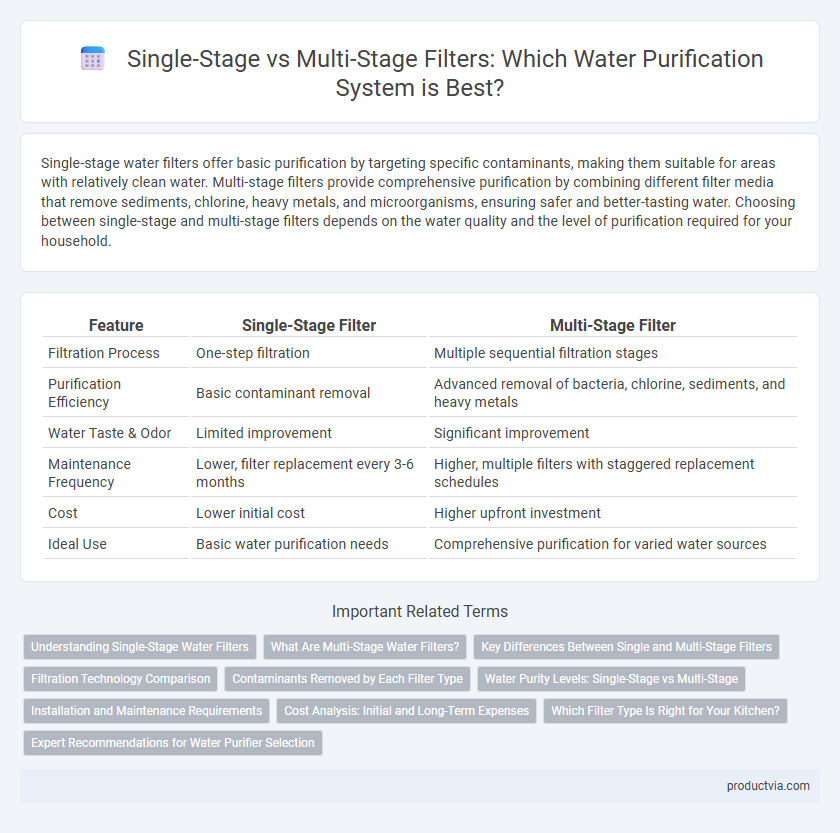Single-stage water filters offer basic purification by targeting specific contaminants, making them suitable for areas with relatively clean water. Multi-stage filters provide comprehensive purification by combining different filter media that remove sediments, chlorine, heavy metals, and microorganisms, ensuring safer and better-tasting water. Choosing between single-stage and multi-stage filters depends on the water quality and the level of purification required for your household.
Table of Comparison
| Feature | Single-Stage Filter | Multi-Stage Filter |
|---|---|---|
| Filtration Process | One-step filtration | Multiple sequential filtration stages |
| Purification Efficiency | Basic contaminant removal | Advanced removal of bacteria, chlorine, sediments, and heavy metals |
| Water Taste & Odor | Limited improvement | Significant improvement |
| Maintenance Frequency | Lower, filter replacement every 3-6 months | Higher, multiple filters with staggered replacement schedules |
| Cost | Lower initial cost | Higher upfront investment |
| Ideal Use | Basic water purification needs | Comprehensive purification for varied water sources |
Understanding Single-Stage Water Filters
Single-stage water filters use one filtration medium to remove specific contaminants such as chlorine, sediment, or certain bacteria, making them simple and cost-effective for basic water purification needs. These filters often utilize activated carbon or ceramic materials that efficiently improve taste and reduce odors but may not address a wide spectrum of pollutants. Understanding their limitations is crucial, as single-stage filters may require frequent replacement and typically do not eliminate heavy metals or complex chemical compounds compared to multi-stage systems.
What Are Multi-Stage Water Filters?
Multi-stage water filters use several filtration processes arranged in sequence to remove a broad range of contaminants like sediment, chlorine, heavy metals, and microorganisms, enhancing water quality significantly compared to single-stage filters. These systems combine different filter media such as activated carbon, ceramic, and ion exchange resins to target specific impurities at each stage, ensuring comprehensive purification. Multi-stage filters provide advanced contaminant reduction, improving taste, odor, and safety for drinking water in residential and commercial applications.
Key Differences Between Single and Multi-Stage Filters
Single-stage water filters utilize one filtration medium designed to remove specific contaminants, making them suitable for basic water purification needs. Multi-stage filters incorporate multiple layers or types of media, targeting a broader range of pollutants including sediments, chlorine, heavy metals, and microbial contaminants, enhancing overall water quality. The complexity and effectiveness of multi-stage filters generally result in improved taste, odor, and safety compared to single-stage counterparts.
Filtration Technology Comparison
Single-stage water purifiers utilize a single filtration medium, such as activated carbon or sediment filters, to remove impurities, making them effective for basic contaminant removal like chlorine and sediments. Multi-stage water purifiers combine various filtration technologies, including pre-filters, activated carbon, reverse osmosis membranes, and UV sterilization, to address a broader range of contaminants such as heavy metals, bacteria, viruses, and dissolved solids. Multi-stage systems generally offer superior purification performance by targeting diverse pollutants through sequential filtration layers, ensuring higher water quality and safety.
Contaminants Removed by Each Filter Type
Single-stage water purifiers primarily remove larger particles, chlorine, and some sediments, effectively improving taste and odor but offering limited removal of heavy metals, bacteria, and viruses. Multi-stage filters combine several filtration technologies such as activated carbon, reverse osmosis, UV purification, and sediment filters, targeting a broader range of contaminants including lead, arsenic, harmful microorganisms, pesticides, and dissolved salts. The comprehensive contaminant removal in multi-stage purifiers ensures safer, cleaner drinking water compared to single-stage systems that are suitable for less contaminated water sources.
Water Purity Levels: Single-Stage vs Multi-Stage
Single-stage water filters typically use one filtration method, such as carbon or sediment filtering, effectively removing basic contaminants like chlorine and large particles but may not eliminate all harmful substances or improve water taste significantly. Multi-stage filters incorporate several filtration technologies, including activated carbon, reverse osmosis, UV purification, and ion exchange, resulting in higher water purity levels by targeting a broader range of contaminants such as heavy metals, bacteria, viruses, and dissolved solids. Consequently, multi-stage systems provide superior purification performance, ensuring safer, cleaner, and better-tasting drinking water compared to single-stage filters.
Installation and Maintenance Requirements
Single-stage water filters typically offer easier installation with fewer components, making them suitable for basic purification needs and quick setup. In contrast, multi-stage filters require more complex installation due to multiple filter cartridges and connections, often necessitating professional help. Maintenance for single-stage filters involves simpler and less frequent cartridge replacements, while multi-stage systems demand regular monitoring and replacement of several distinct filters to ensure optimal performance.
Cost Analysis: Initial and Long-Term Expenses
Single-stage water purifiers generally have a lower initial cost, making them budget-friendly for basic water filtration needs. Multi-stage filters involve higher upfront expenses due to multiple filtration components but offer better long-term value by extending filter lifespan and improving water quality. Maintenance costs for multi-stage filters tend to be higher, but the enhanced purification efficiency can reduce health-related expenses over time.
Which Filter Type Is Right for Your Kitchen?
Single-stage filters are ideal for kitchens needing basic filtration to remove chlorine and sediment, offering affordability and easy maintenance. Multi-stage filters provide comprehensive purification by combining carbon, UV, and RO technologies, effectively eliminating contaminants like heavy metals, bacteria, and viruses. Choosing the right filter depends on your water quality, budget, and health requirements for optimal kitchen water safety.
Expert Recommendations for Water Purifier Selection
Experts recommend multi-stage filters for water purification due to their comprehensive removal of contaminants including sediments, chlorine, heavy metals, and microorganisms. Single-stage filters may effectively target specific impurities but lack the broad-spectrum protection offered by multi-stage systems, which combine technologies like activated carbon, reverse osmosis, and UV sterilization. Choosing a multi-stage purifier ensures higher water quality and safety, aligning with expert guidelines for optimal household water treatment.
Single-Stage Filter vs Multi-Stage Filter for purification Infographic

 productvia.com
productvia.com